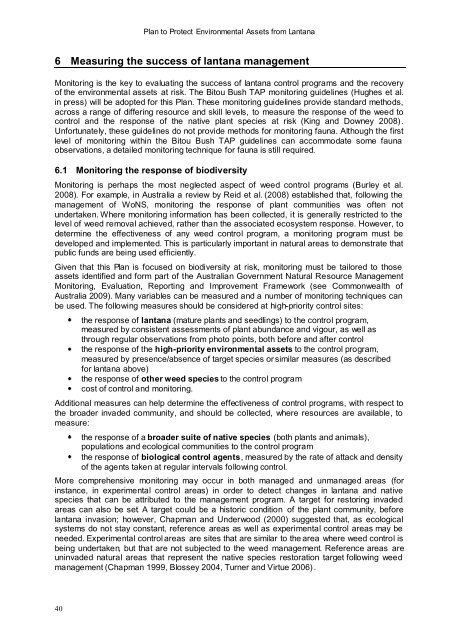Plan to Protect Environmental Assets from Lantana - Weeds Australia
Plan to Protect Environmental Assets from Lantana - Weeds Australia
Plan to Protect Environmental Assets from Lantana - Weeds Australia
Create successful ePaper yourself
Turn your PDF publications into a flip-book with our unique Google optimized e-Paper software.
<strong>Plan</strong> <strong>to</strong> <strong>Protect</strong> <strong>Environmental</strong> <strong>Assets</strong> <strong>from</strong> <strong>Lantana</strong><br />
6 Measuring the success of lantana management<br />
Moni<strong>to</strong>ring is the key <strong>to</strong> evaluating the success of lantana control programs and the recovery<br />
of the environmental assets at risk. The Bi<strong>to</strong>u Bush TAP moni<strong>to</strong>ring guidelines (Hughes et al.<br />
in press) will be adopted for this <strong>Plan</strong>. These moni<strong>to</strong>ring guidelines provide standard methods,<br />
across a range of differing resource and skill levels, <strong>to</strong> measure the response of the weed <strong>to</strong><br />
control and the response of the native plant species at risk (King and Downey 2008).<br />
Unfortunately, these guidelines do not provide methods for moni<strong>to</strong>ring fauna. Although the first<br />
level of moni<strong>to</strong>ring within the Bi<strong>to</strong>u Bush TAP guidelines can accommodate some fauna<br />
observations, a detailed moni<strong>to</strong>ring technique for fauna is still required.<br />
6.1 Moni<strong>to</strong>ring the response of biodiversity<br />
Moni<strong>to</strong>ring is perhaps the most neglected aspect of weed control programs (Burley et al.<br />
2008). For example, in <strong>Australia</strong> a review by Reid et al. (2008) established that, following the<br />
management of WoNS, moni<strong>to</strong>ring the response of plant communities was often not<br />
undertaken. Where moni<strong>to</strong>ring information has been collected, it is generally restricted <strong>to</strong> the<br />
level of weed removal achieved, rather than the associated ecosystem response. However, <strong>to</strong><br />
determine the effectiveness of any weed control program, a moni<strong>to</strong>ring program must be<br />
developed and implemented. This is particularly important in natural areas <strong>to</strong> demonstrate that<br />
public funds are being used efficiently.<br />
Given that this <strong>Plan</strong> is focused on biodiversity at risk, moni<strong>to</strong>ring must be tailored <strong>to</strong> those<br />
assets identified and form part of the <strong>Australia</strong>n Government Natural Resource Management<br />
Moni<strong>to</strong>ring, Evaluation, Reporting and Improvement Framework (see Commonwealth of<br />
<strong>Australia</strong> 2009). Many variables can be measured and a number of moni<strong>to</strong>ring techniques can<br />
be used. The following measures should be considered at high-priority control sites:<br />
the response of lantana (mature plants and seedlings) <strong>to</strong> the control program,<br />
measured by consistent assessments of plant abundance and vigour, as well as<br />
through regular observations <strong>from</strong> pho<strong>to</strong> points, both before and after control<br />
the response of the high-priority environmental assets <strong>to</strong> the control program,<br />
measured by presence/absence of target species or similar measures (as described<br />
for lantana above)<br />
the response of other weed species <strong>to</strong> the control program<br />
cost of control and moni<strong>to</strong>ring.<br />
Additional measures can help determine the effectiveness of control programs, with respect <strong>to</strong><br />
the broader invaded community, and should be collected, where resources are available, <strong>to</strong><br />
measure:<br />
the response of a broader suite of native species (both plants and animals),<br />
populations and ecological communities <strong>to</strong> the control program<br />
the response of biological control agents, measured by the rate of attack and density<br />
of the agents taken at regular intervals following control.<br />
More comprehensive moni<strong>to</strong>ring may occur in both managed and unmanaged areas (for<br />
instance, in experimental control areas) in order <strong>to</strong> detect changes in lantana and native<br />
species that can be attributed <strong>to</strong> the management program. A target for res<strong>to</strong>ring invaded<br />
areas can also be set. A target could be a his<strong>to</strong>ric condition of the plant community, before<br />
lantana invasion; however, Chapman and Underwood (2000) suggested that, as ecological<br />
systems do not stay constant, reference areas as well as experimental control areas may be<br />
needed. Experimental control areas are sites that are similar <strong>to</strong> the area where weed control is<br />
being undertaken, but that are not subjected <strong>to</strong> the weed management. Reference areas are<br />
uninvaded natural areas that represent the native species res<strong>to</strong>ration target following weed<br />
management (Chapman 1999, Blossey 2004, Turner and Virtue 2006).<br />
40

















